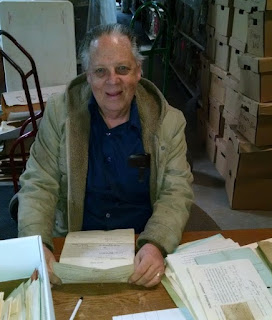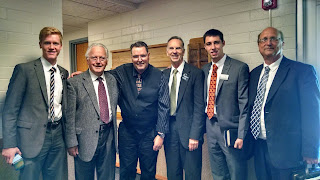Before I begin my "serious" posting, I wanted to share some not-so-serious thoughts. Over the last seventeen months, we have read thousands of names. The majority are very common: William, Jane, Mary, John, Richard. But we have found some beautiful and unusual names also. We were surprised at how many times the name Cynthia was used 150 years ago. To add a little humor to our work, we sometimes have fun with names. For example, we saw the name of Visa. It's a beautiful name. What if she married Mr. Card? Another example, Mr. Bopp was a local merchant in Terre Haute. Perhaps he would name his daughter Beatrice, or Bea for short. Another surprisingly common name was Cinderella, maybe a version of Cynthia. Would she have enough love to marry Mr. Ball or Mr. Prince? This has been a fun exercise to help break up the tedious work.
 |
| Celebrating when we finished capturing Box 300 |
And now on to more substantial thoughts. "Totem poles serve as important illustrations of family lineage and the cultural heritage of native peoples... [and] symbolize characters and events of a myth or relate the experiences of known ancestors or living people." (Wikipedia) One of the tallest totem poles is over 173 feet high. The largest has been measured over 6 feet in diameter. I am fascinated by totem poles. They could possibly have a place in family history research.
 |
| The entrance to the Vigo County Historical Museum |
The vertical order of images on a pole is thought to be significant. If an image or depiction is on the bottom, or "low man on the totem pole," it gives the impression that the higher figures were more important or prestigious. The higher, the better, I guess. But on the other hand, some of the totems are arranged in reverse hierarchy with the most important representations on the bottom. As in art, an eye level view focuses on what or who is most significant.
 |
| Resting place of Chauncey Rose. |
In past blogs we have introduced you to some very prominent men in the early history of Vigo County: Levi Warren, Josephus Collett, and Chauncey Rose. In some views, their stories would be carved on the top of the totem pole. While their contributions are interesting and noteworthy, there are hundreds of ordinary people on the lower tier of the pole who deserve honor and remembrance.
About a month ago we captured a two sided document that tugged at our heart. It was a request to the Circuit Court from parents for reimbursement of living expenses for their young adopted daughter. Here's what the application states:
 |
|
Sir: We respectfully ask you to make us an allowance for the
support and maintenance of your said Ward.
She is now past 6 years old. Her
mother who was a young girl, came to Terre Haute and the child was born here
and the mother died within 24 hours after the birth of the child. Mrs. Donaway saw the mother just before the
birth and the mother made her promise to take the child and care for it if she
died, and she agreed to do so. The
mother was never conscious after the birth and Mrs. Donaway took the child home
and took care of it as her own. It was a
beautiful girl baby. When about 3 years
of age we applied to the Circuit Court and had the child duly adopted and have
ever since loved it and cared of it as a favorite daughter, having no other
children... Benjamin Donaway and Lottie J Donaway.
 |
| We are grateful for temples that bring families together. |
Our purpose as FamilySearch missionaries is to get these kind of documents into the hands of a great grandson or niece to do additional research. Who was the young mother, perhaps only 14 or 15 years old herself? Why did she come to Terre Haute? What was her name? Who was the father? Where was she buried? This young mother deserves to be remembered. Benjamin and Lottie have a story to tell as well. They all need a place on the totem pole.
If I could carve my ancestry back several generations on a totem pole, what would I say about my legacy?
 |
| Sarah Ann Andrews Arave |
Sarah Ann Andrews Arave was born in 1869. In her personal history, people recall her "enchanting singing voice...she was called upon to sing at nearly every dance. She knew many songs and enjoyed singing, whether it was a tune at Muncy's or a lullaby to one of her children."
 |
| Elva Aroline Arave Bennett |
My grandmother, Elva Aroline Arave Bennett was born in 1901. I remember sitting by her in church most Sundays and wanting to sing alto harmony like her. Some of my best memories are accompanying her and my grandfather as they sang duets together.
 |
| Zelma May Bennett Singleton |
My mother, Zelma May Bennett Singleton was born in 1922. It was on her insistence that each of her daughters learn to play the piano. I can still hear her voice as she would sing "Mairzy doats and dozy doats and liddle lamzy divey" while toting a baby on her knee.
 |
| My totem pole. |
Ralph Waldo Emerson has said: "In different hours, a man represents each of several of his ancestors, as if there were seven or eight of us rolled up in each man's skin, -- seven or eight ancestors at least, and they constitute the variety of notes for that new piece of music which his life is."
What's carved on your totem pole?






















































